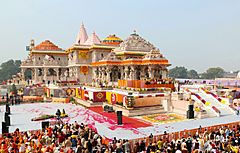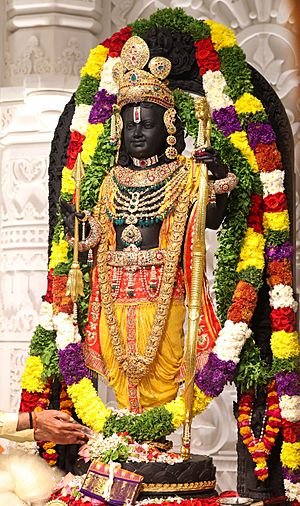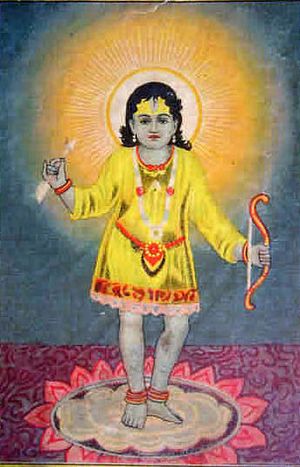Ram Mandir facts for kids
Quick facts for kids Ram Mandir |
|
|---|---|

Ram Janambhoomi Mandir
|
|
| Geography | |
| Coordinates | 26°47′44″N 82°11′39″E / 26.7956°N 82.1943°E |
| Country | India |
| State | Uttar Pradesh |
| Location | Ram Janmabhoomi, Ayodhya |
| Architect | Sompura family |
| History and governance | |
| Creator | Shri Ram Janmabhoomi Teerth Kshetra |
| Temple board | Shri Ram Janmabhoomi Teerth Kshetra |
The Ram Mandir or Ram Temple is a Hindu temple located in Ayodhya, a city in Uttar Pradesh, India. This temple is built on a site that many Hindus believe is the birthplace of the Hindu god Rama. The city of Ayodhya is considered a very holy place by many people.
Contents
Temple Design
The first ideas for the Ram Mandir's design came about in 1988. These plans were created by the Sompura family from Ahmedabad, who are famous architects. This family has designed over 100 temples around the world for more than 15 generations. They even helped design the Somnath temple.
New Plans for the Temple
In 2020, the Sompura family made new plans for the temple. They followed ancient Hindu texts like the Vastu shastra and the Shilpa shastras for the design. The temple will be about 76 meters (250 feet) wide, 116 meters (380 feet) long, and 49 meters (161 feet) high. Once it's finished, it will be one of the largest Hindu temples in the world.
Architecture Style
The temple is designed in the Nagara style of Hindu temple architecture. This style is mostly found in northern India. A small model of the temple was shown at the Prayag Kumbh Mela in 2019.
The main part of the temple stands on a raised platform and has three levels. It has five special halls called mandapas. These halls are located around the main prayer room, called the garbhagriha (sanctum sanctorum), and along the entrance path. In the Nagara style, these mandapas are decorated with tall towers called shikharas.
Temple Features
The temple will have 366 columns in total. Each column is decorated with 16 idols. These idols include different forms of Shiva, the 10 Dashavataras (forms of Vishnu), the Chausath Yoginis, and 12 forms of the goddess Saraswati. The stairs leading up to the temple are about 4.9 meters (16 feet) wide.
The main prayer room, the sanctum sanctorum, is shaped like an octagon. This shape is special for temples dedicated to Vishnu. The temple building itself covers about 4 hectares (10 acres) of land. The rest of the land, about 23 hectares (57 acres), has other buildings. These include a prayer hall, a lecture hall, an educational center, a museum, and a cafeteria. The temple committee believes the site can welcome up to 70,000 visitors.
Construction Details
Larsen & Toubro, a big construction company, offered to build the temple for free. Other groups like the Central Building Research Institute and several IITs (like Bombay, Guwahati, and Madras) helped with things like testing the soil and designing the concrete.
The temple is built using 17,000 cubic meters (600,000 cubic feet) of sandstone from Baansi in Rajasthan. No iron or steel was used in building the temple. Instead, ten thousand copper plates were used to connect the stone blocks. As a special gesture, Thailand also sent soil to the Ram Janmabhoomi to honor the temple's opening. They had previously sent water from two rivers in Thailand.
Main Deity

The main deity, or god, worshipped in the temple is Ram Lalla Virajman. This means the infant form of Rama, who is an avatar (form) of Vishnu. The clothes for Ram Lalla's idol were made by tailors Bhagwat Prasad and Shankar Lal. They are from a family that has been making clothes for Rama's idol for four generations.
The idol statue of Rama was created by Arun Yogiraj from Mysore, Karnataka.
Temple Opening (2024)
The Prime Minister of India, Narendra Modi, led a special ceremony for the temple's opening on January 22, 2024. This ceremony is called Prana Pratishtha. Some people chose not to attend the ceremony because the temple was not fully finished yet. This goes against some beliefs in the Hindu religion.
Related pages
- Ram Mandir (disambiguation)
Images for kids
-
PM Narendra Modi and CM Yogi Adityanath unveiling a plaque to mark the start of construction.









